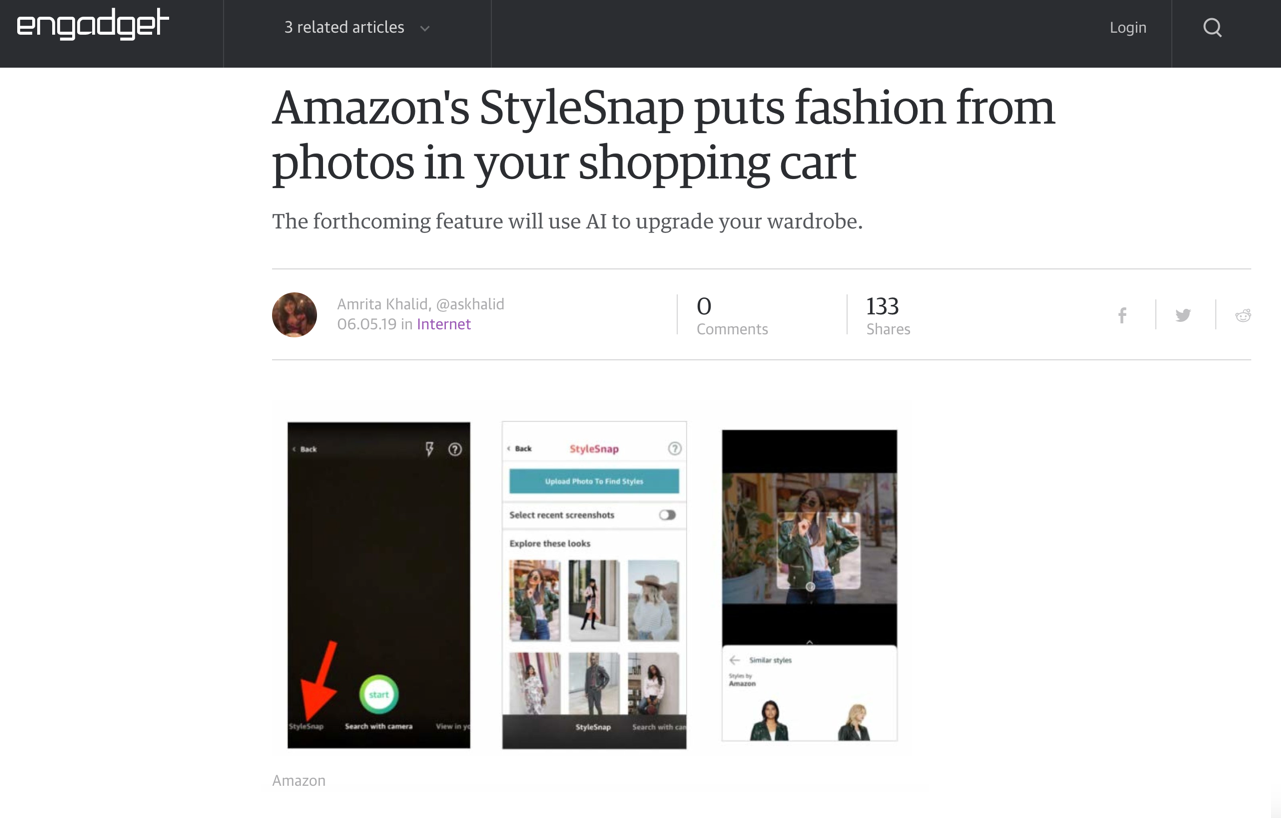OVERVIEW
Amazon StyleSnap
2018 — 2019
StyleSnap is a new visual search experience launched in the Amazon App to help customers easily discover inspiring fashion products on Amazon based on pictures they see posted by brands and influencers on social media feeds or from any other website. Customers can upload photos or screenshots of inspirational looks, or explore the looks of Amazon Fashion Influencers, to find visually or aesthetically similar styles on Amazon.
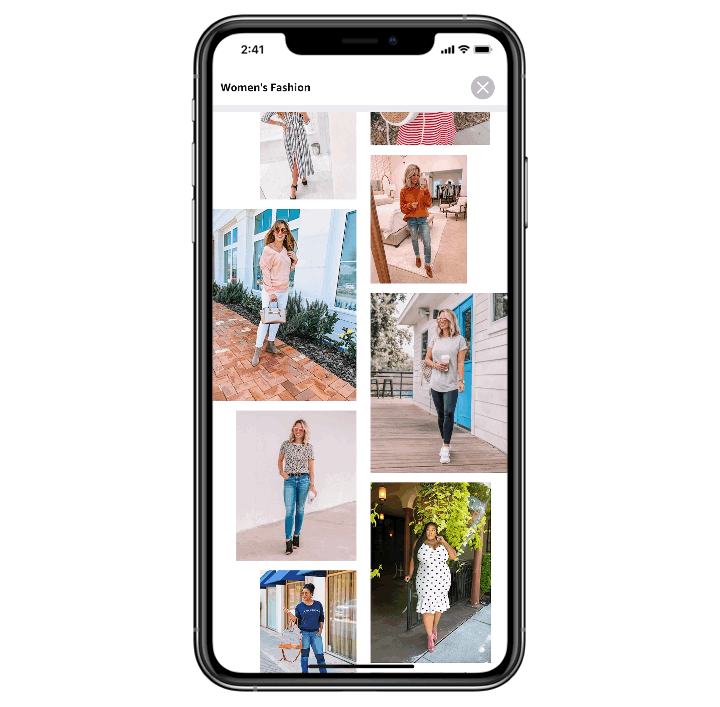
Goal: Design an intuitive experience that takes the guesswork out of shopping from inspiration using AI, Android and IOS.
Users: All Amazon app users.
Why: Customers struggle to find products from their visual inspirations that inspire purchases (i.e. pictures on social media, fashion bloggers) and some pictures lack sufficient information making them have to go through a major filtering, sorting, typing and re-typing exersise, to figure out how to describe what they are looking for. Leveraging machine learning, we can identify the visual characteristics of an image such as pattern, color, length etc, to provide customers similar looking products based on their inspirations.
Role: Lead designer, UX/UI design, prototyping, user research, product vision and strategy.
Collaborations: I collaborated with another designer, multiple computer vision engineers, an engineering manager, a PM and received input and feedback on my designs from Amazon Fashion and Amazon Search designers.
Process: My role as Design Lead was to work collaboratively with design, science, computer vision, product management and engineering to deliver an intutive end-end flow. I worked with partner teams in Amazon Fashion and Amazon Search, to surface best practices around the display, filtering and saving of products, as well as led research (using usertesting.com) for identifying motivations for using photos in the shopping journey.
Outcome: StyleSnap is live today in the Amazon mobile app. It is also a 4 year effort for me to push visual search for fashion into the Amazon App since my work as an intern on Amazon Visual Fashion Finder.
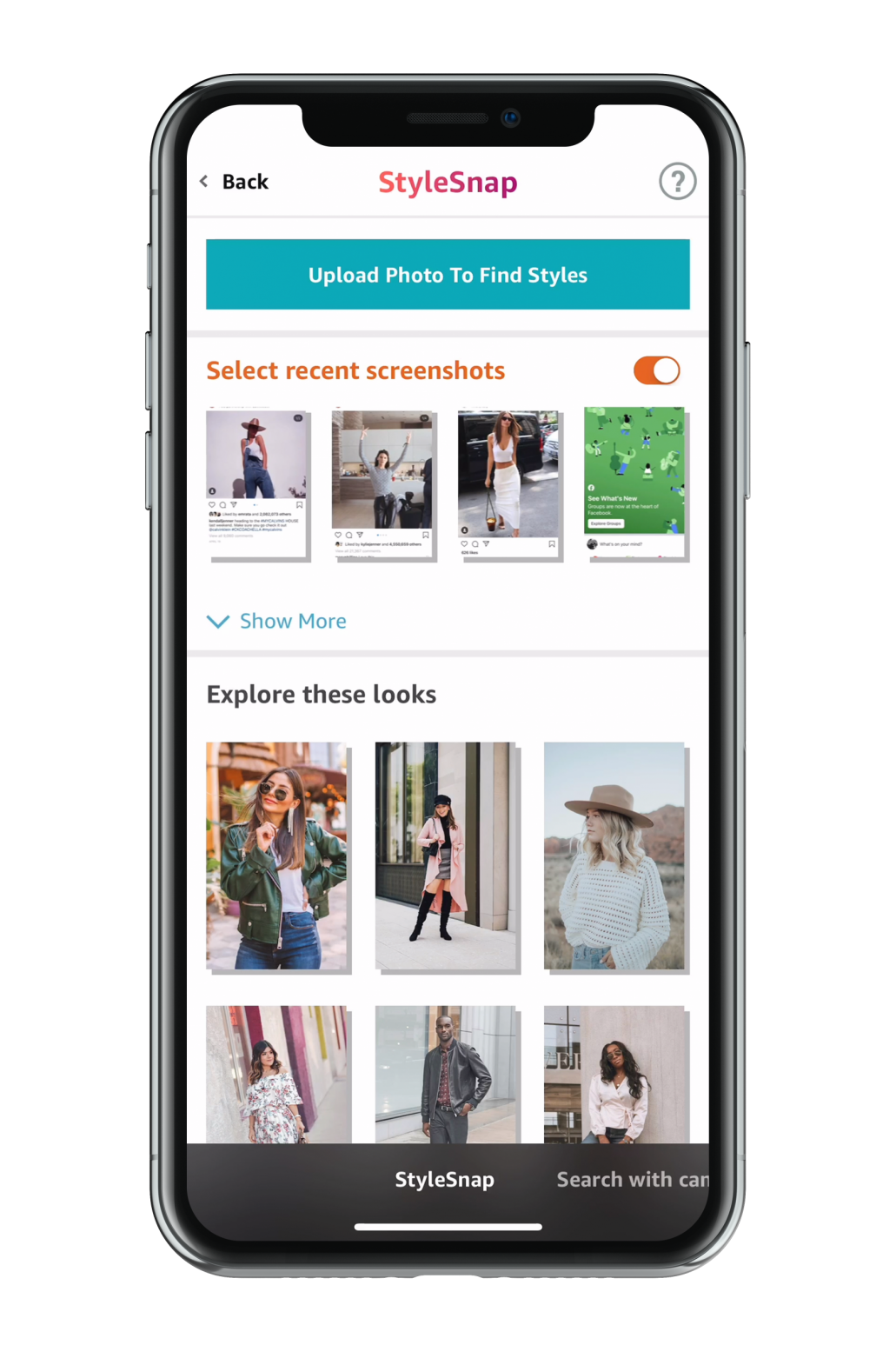
STARTING POINTS
We wanted to encourage customers to upload their saved photos from their camera roll and found screenshots to be a common behavior. These starting points take priority in the interface. However, users may not always have a photo or screenshot ready, so we worked with the Amazon Influencer Program to surface influencer images that have a variety of genders and body types as well as exact products recommended by the influencer as another starting point.

ACCESSIBLE INSPIRATION
Using deep learning we are able to recognize and visualize the different aspects of the photo that have products in them. Customers are able to navigate the large preview of the image they uploaded to see what the most similar styles available on Amazon. It was important to balance the ability to see the original inspiration clearly against showing products, so the customer can visually compare, pivot to other aspects of the image or swipe up if they want to dive deeper.

PRODUCT THUMBNAILS AND FILTERS
Once customers scroll to full screen, they can toggle thumbnails between the different aspects of the photo to see all the products available within a few seconds. The filters surfaced are the most important for the category, letting customer know which gender was recognized automatically along with Prime, Price and Size. The product grid is also optimized for the category, ensuring large images to compare to the original inspiration thumbnails.
USER-CENTERED APPROACH
The Customer
In today's world, we have entirely new kinds of shoppers and ways of shopping.
As the customer path to purchase becomes predominantly digital, seamless and predictive, consumers are spending more of their waking hours in a near-constant ‘shopping mode.’ People no longer ‘go’ shopping, but are shopping, all the time and everywhere.
Social media now plays a big part in their shopping journey as well as the customer experience.
Top Customer Frustrations with current experience
Customers don’t always have the words to describe what they are looking for.
They are frustrated by struggling to find styles from their visual inspirations that inspire purchases because some pictures lack sufficient information making them have to go through a major filtering, scrolling and re-typing exercise. And even if found can cost more than they want to spend.
Customer Problem/Opportunity
Customers want to buy exact or similar looking items like they see in photos or “in the wild” (e.g., on friends).

Iterations and End-End Flow Refinement
One of the biggest design challenges was discoverability. When my PM and I worked with an external research partner to conduct diary studies we found that once customers were aware of the capability to upload a photo, they were excited and delighted. This meant the end-end flow had to be discoverable and the experience as frictionless as possible to get from the selection of a photo to an ideal result. The flow was essentially 3 steps, 1) select camera, select photo, see results, which is why animation played an important factor. It needed to feel easy and seamless.

Partner Collaboration: Search Design and Systems
Loom was Amazon Search’s new system for displaying products. Different categories that were more visual such as fashion, had different “ingredients” and it was important that I kept the experience as visual as possible but also as close to the existing system for displaying results as much as possible. Fashion had also been working on differentiating their search results to be more visually appealing, less textual so I factored in all of those influences when developing the design of the result page.
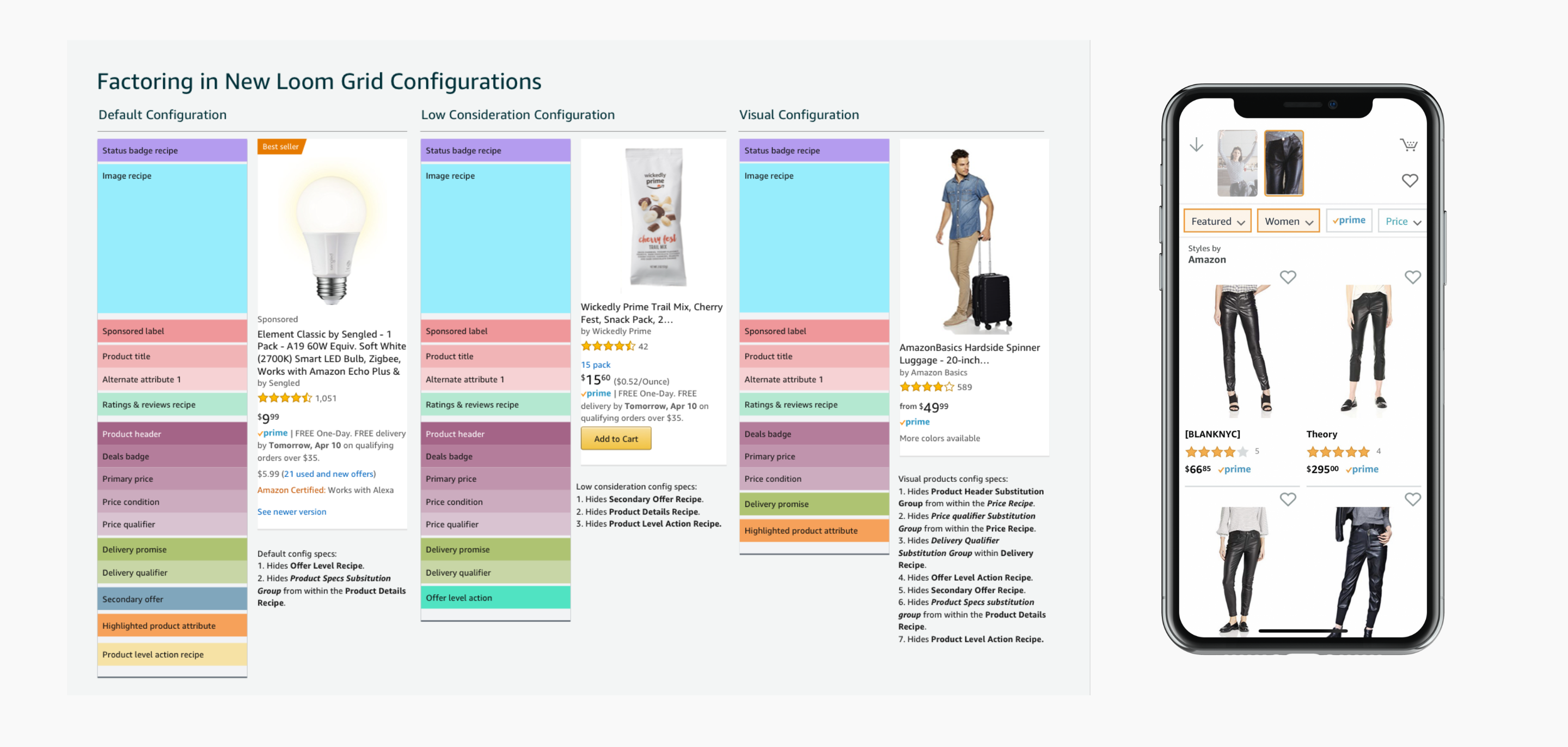
Lightweight Qual on Result Quality
I concurrently aided PM/Engineering with evaluation of result quality.

Improved Influencer Image Discovery
My last work on the project was improving the discoverability of influencer looks. With the improved design, customers can navigate from the camera as they would through a fashion experience. Instead of presenting an organic grid of photos, we present 4 gender and category based options to remove cognitive dissonance. Once more personalized, they can continue to narrow down with category filters or start discovering products from the influencers. All designs were tested by me in usertesting.com.
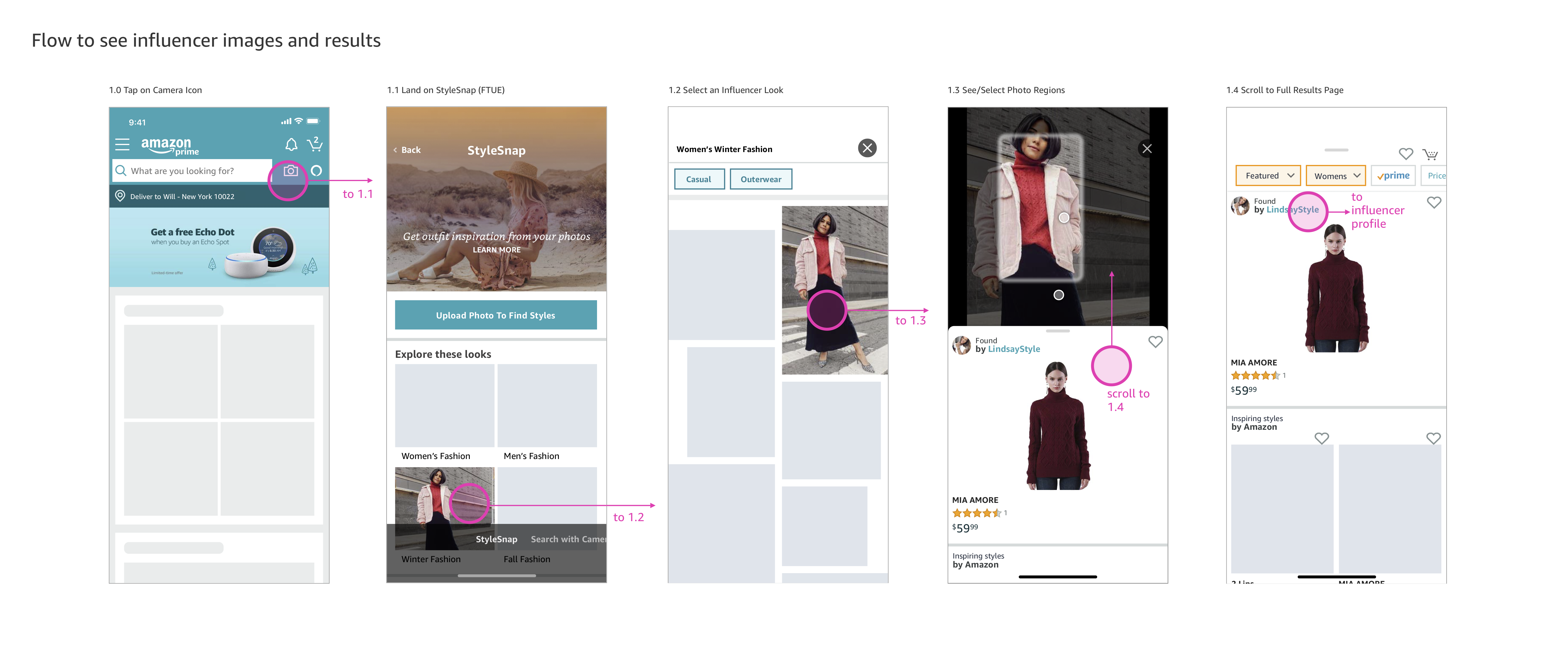
TOP CHALLENGES
1. Technology is only as good as it is valuable
2. Distance from the social graph is a gap
3. The ideal experience for consumers isn’t ideal for influencers (content creators)
Selected Works

Instagram Shopping Try On #Software #ARProduct Design

Facebook Spark AR Commerce #SpeakingProduct Design

Amazon StyleSnap #Software #VisualSearchUpload photos or screenshots to find visually similar styles on Amazon #VisualSearch #Mobile

Amazon Camera Modality #Software #ARBiggest redesign of Visual Search technology across Amazon #Mobile #AR #Camera

Amazon Package X-Ray #Software #ARSee which of your packages holds which gift, without opening them #Mobile #AR #Camera

Amazon Publisher Services #Desktop #CloudNew suite of cloud services, built to monetize and grow your media business #Desktop #Advertising

Amazon Visual Fashion Finder #Software #AIFilter the most important aspects when shopping for garments #Mobile #Internship #Fashion #AI
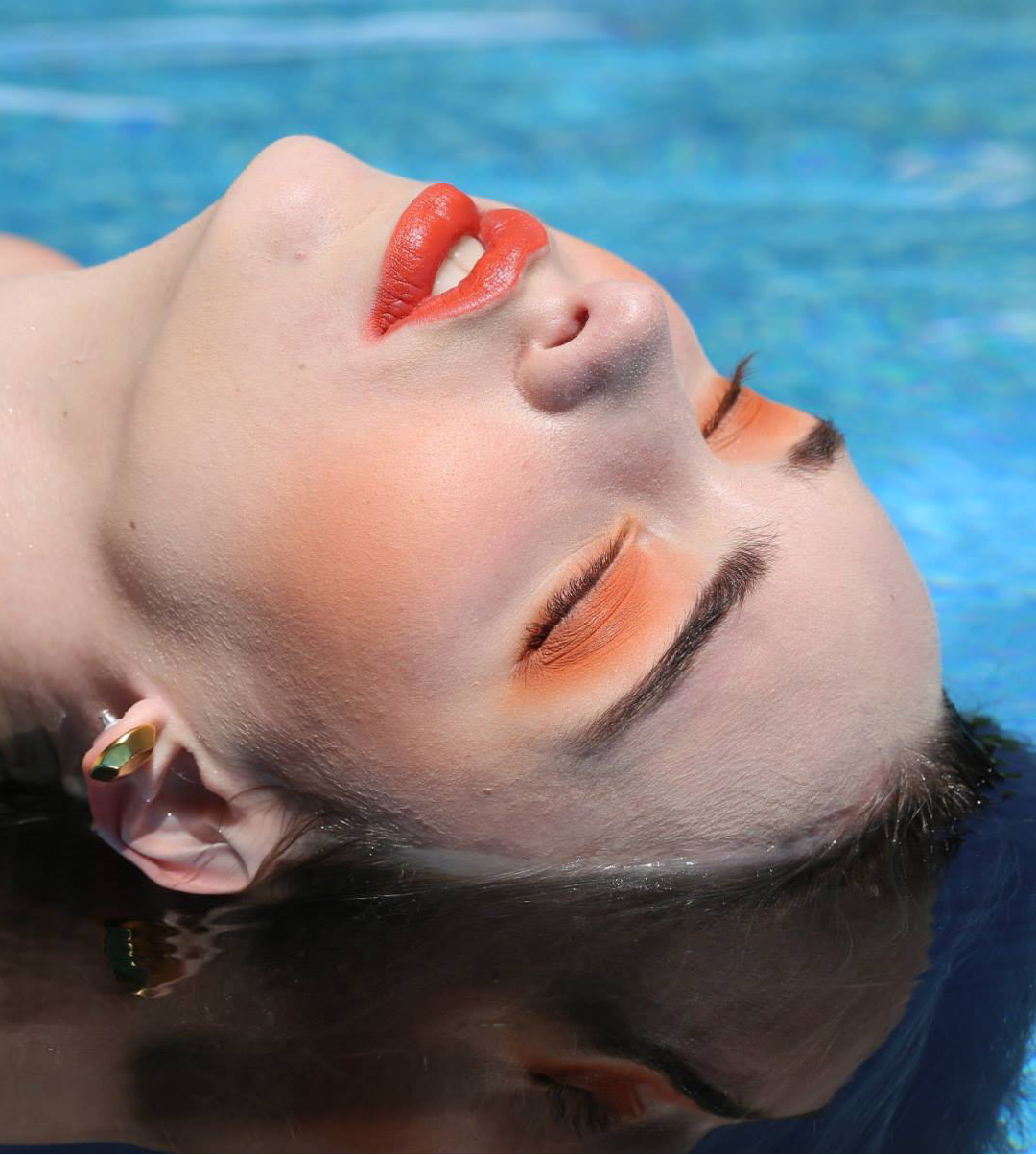
Photography #ArtDirection #PrintCollection of photographed International Editorials #Print #Digital #Identity #Photography
© 2025 Andrea Alam

